Diving Nusa Penida, Bali
The islands of Nusa Penida and Lembongan, just off Bali, are one of those magical places where large waves pound the shores, and strong currents bring nutrients from the deep, creating a veritable explosion of underwater life. I spent 4 days scuba diving there with my partner Lisa, and even in this short period of time we had some of the most memorable underwater encounters we have ever experienced. So let’s jump in!
The Dive Sites of Nusa Penida and Lembongan
Nusa Penida is a small island off the southeast corner of Bali, and next to it is an even smaller island, Nusa Lembongan. It takes about an hour and a half by boat from the main island of Bali (depending on boat speed - it can be closer to one hour with a fast boat). The best-known and busiest dive sites on Nusa Penida are Manta Point and Crystal Bay, famous for mantas and mola mola, respectively. But there are also a wealth of other less busy and less famous dive sites with spectacular reefs and underwater life. Here is a map of the dive sites - check out this website for a clickable version where you can learn more about each individual dive site.
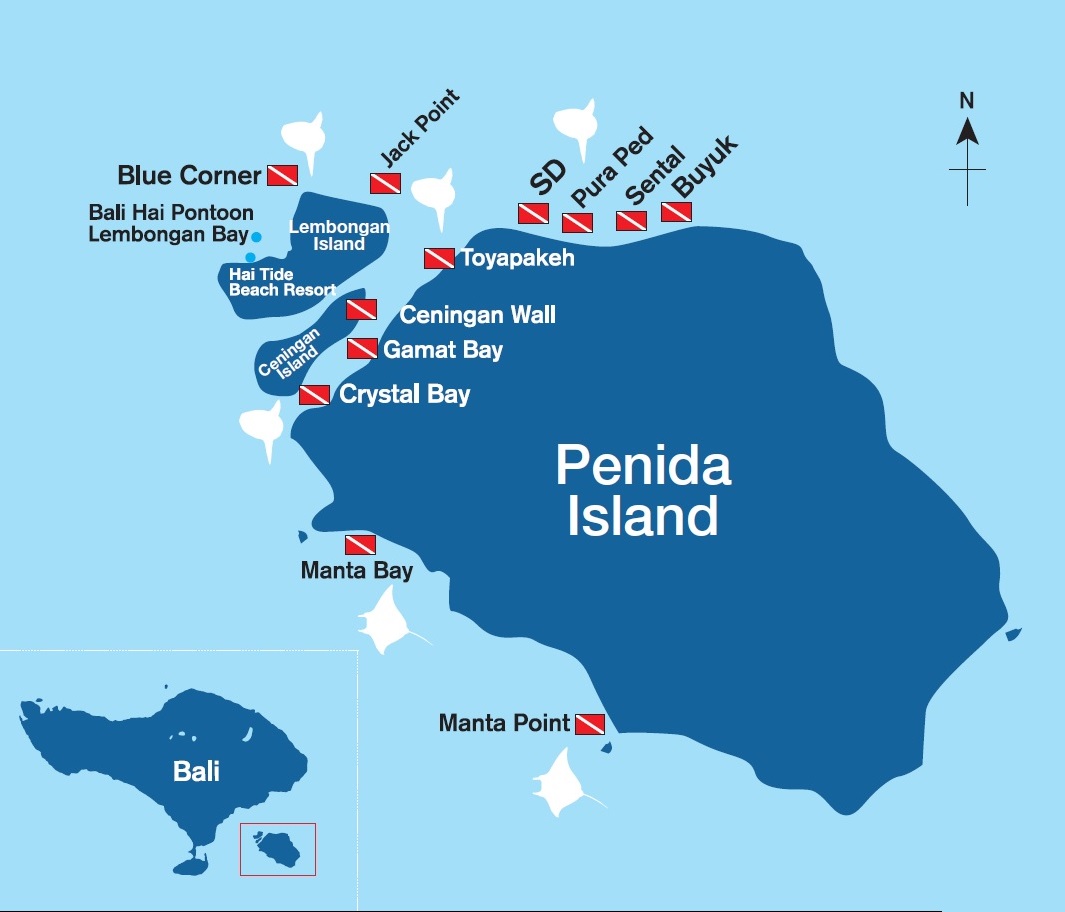
There are a lot of boats that depart from Bali every morning, doing long day trips out and back – as you can imagine, especially if the crossing is rough, that can make for long days. It also makes it difficult to get there early and beat the rush. We chose to stay on Nusa Lembongan at the Hai Tide Beach Resort, diving with their in-house outfit Bali Hai Diving Adventures, which was pretty much an ideal setup. The resort was fantastic, as was the dive shop, and being so close to the action, we were able to save a lot of time that would otherwise have been spent riding a boat back and forth from Bali.
To get to Manta Point, we just departed the resort at 7:15 am, with a packed breakfast from the kitchen. We were the first or second boat to the dive site, and were in the water before 8. By the time we surfaced, there were at times over 30 boats in the area, with more arriving. Most were doing daytrips from Bali.
After Manta Point, we would head over to another dive site, maybe Crystal Bay or one of the many other beautiful reef sites, head back to the resort for lunch, and then head back out for an afternoon dive. Something along those lines.
If you want to just dive Manta Point and Crystal Bay once, then you might just want to dive from the main island of Bali, and have a very long day trip. But if you want to dive the area properly, and see what Nusa Penida really has to offer, then it is a much better choice to stay on Nusa Lembongan or Nusa Penida. You have a lot more flexibility for timing, can get to the busy dive sites before the bulk of other boats, and can relax on land in between the morning dives and the afternoon dive. I go into more details at the bottom of the article on When to Dive (there are a lot of variables) as well as How to Dive these special islands.
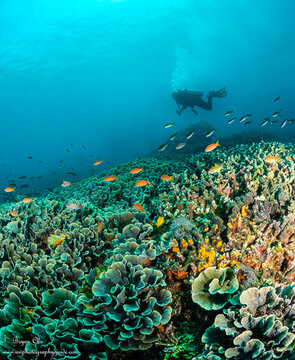
Why Dive Nusa Penida?
There are a lot of reasons, so I have broken them down into the highlights of my 4 days diving the area.
- Manta madness and mayhem
- Delightful drifts over pristine, prismatic reefs
- Tons of tranquil turtles
- Super-sized sponges
- Crazy Crystal Bay
- An Opportune Octopus show
- Laid-back Lembongan house reef
Mantas Madness and Mayhem
Manta Point is very aptly named. It consists of a large plateau at about 15-20 m (40 - 60 ft), and a small pinnacle that rises up to maybe 3 m (10 ft) depth, or a bit less. This is the cleaning station, and it gets busy, both with divers and with mantas! Our first dive we saw a few mantas, some about 2-3 m across, and a couple maybe 4 m plus. We had one swim by pretty close, but unfortunately we had a lot of divers in the area and there were a lot of bubbles, making photos difficult.
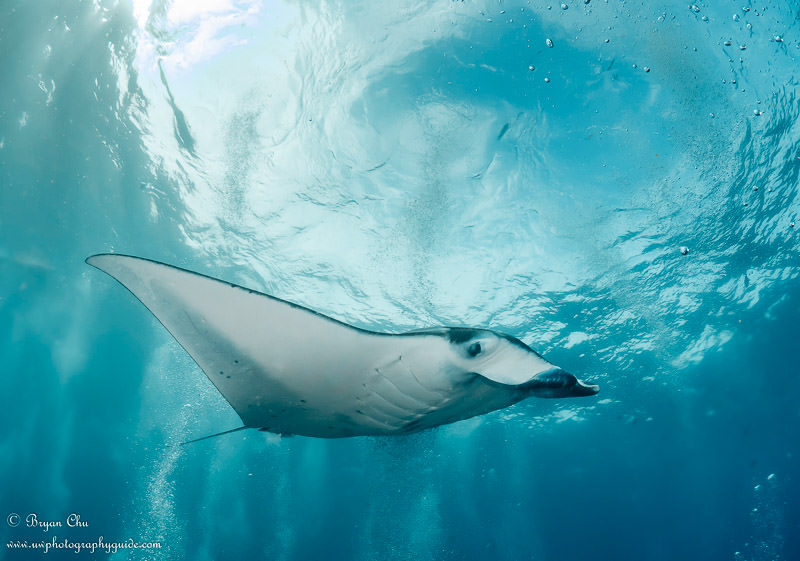
We were told this amounted to a very quiet day at manta point – seeing a handful of these graceful wanderers, but only having one come particularly close.
The next time we hit up Manta Point, we spent more of our time circling around the plateau, avoiding the busy pinnacle. The dive site was large enough that even with a lot of groups in the water, we were able to find our own space without other divers in sight. We saw a number of mantas swimming around, coming pretty close but not close enough. After all, this is a manta dive, so the visibility is not the best - shooting a manta that is still 5 to 10 m away is going to look murky at best, no matter how high you set your strobes. Then I caught some motion out of the corner of my eye, and turned to see our dive guide frantically gesticulating and pointing right behind me. I turned and saw a beautiful, 4 m (13 ft) manta swimming right towards my head!
Fortunately, I had already done my test shot and had my settings dialed in for a large manta passing 1-2 m above me. Without even having to swim much, that is exactly what happened, as the beautiful giant swam right over me! Wow!! I think I might have to wear a helmet next time I dive Manta Point!
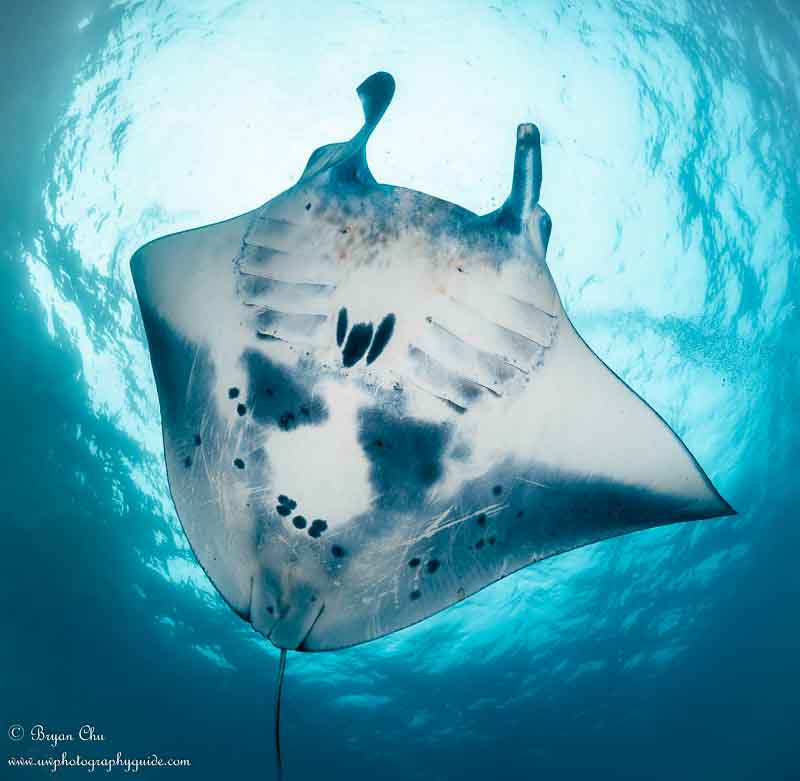
We had more close manta encounters, but no more as good as that one. When we got back on the boat, all pumped and excited, we were told that a couple of weeks prior to our visit, they were seeing as many as 15 mantas at Manta Point!
Pristine Drift Diving
When my dive guide and I dropped in at Toyapekah/Mangrove Point, we were immediately caught up in a swift-moving current. Next thing you know, we were drifting over prismatic reefs, cloaked in colorful fish of all varieties. Ducking in behind a coral bommie, we were treated to a large school of curious batfish, who liked hovering around and examining us.
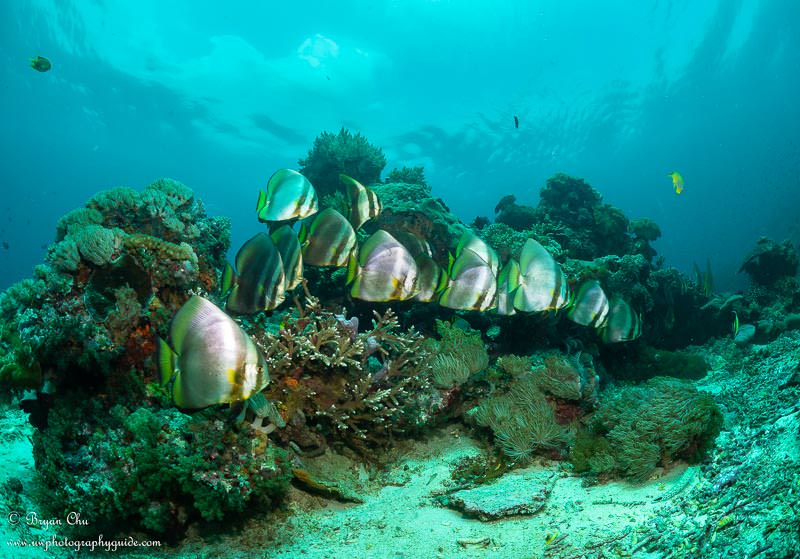
We crawled around on the sand and looked at them from a few angles, and just took in the spectacle. The more we sat still, the more all of the reef fish became accustomed to us and the closer they came. A large school of rainbow runners slowly came closer and closer, and we held our breaths so as not to scare them. They circled us and circled the reef, while the batfish crept closer from the other direction to check us out some more. It really felt like we were a part of the reef community, rather than being clumsy, noisy, bubble-making interlopers.
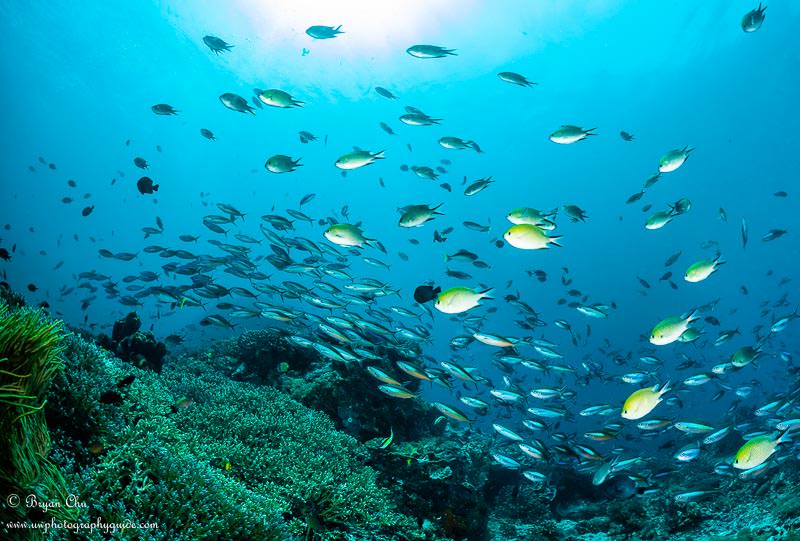
After enjoying this scene for quite a few minutes, we decided it was time to get back into the current, so that we could make it to the pick-up area by the end of the dive. We drifted over more beautifully healthy coral, and then we were back to the boat, a 10 minute ride from the resort and a relaxing afternoon.
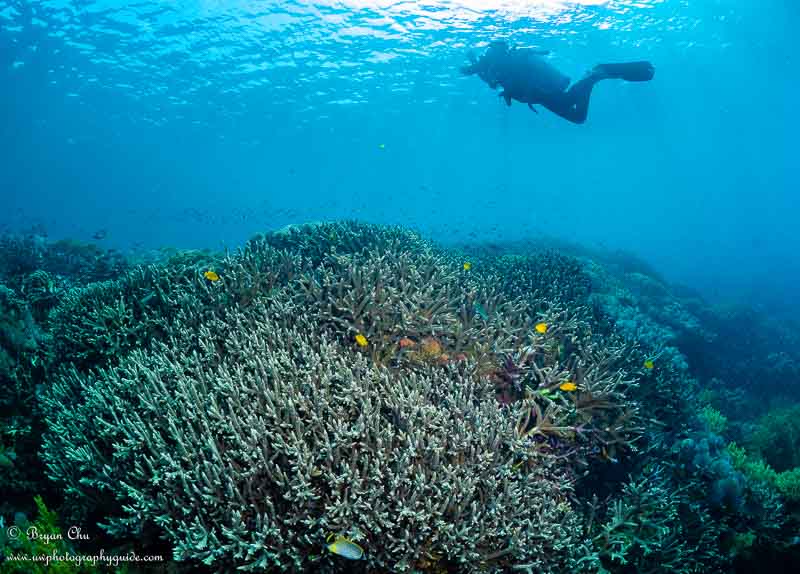
Tons of Tranquil Turtles
Some of the dive sites, like Crystal Bay and Manta Bay, had hawksbill turtles. Hawksbill turtles are really funny, as they are 100% focused on eating what appears to be terribly undigestible sponges, and 0% concerned with underwater photographers getting their camera rigs right in front of them. They don’t even seem to miss a beat when I creep in close with my fisheye lens.
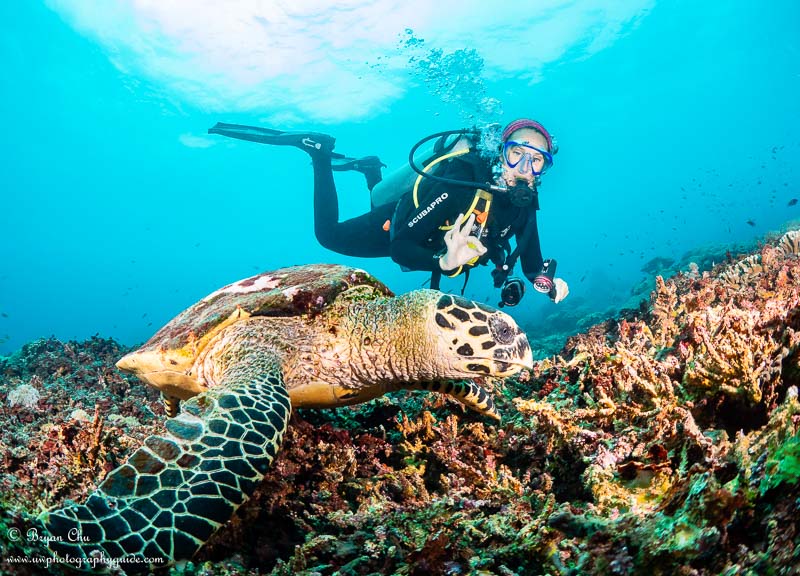
Although hawksbills are hilarious, they also don’t have the photogenic looks and beautiful shells of the green sea turtles. Fortunately, Nusa Penida also has green sea turtles galore. While drifting at Sental dive site, we saw one large green sea turtle after another, for a total of at least five. Although green turtles are generally more shy than hawksbill turtles, these green sea turtles were pretty relaxed and chilled out. Some were sitting atop sponges, some where down on the rocks, and a couple were even scraping their shells against hard corals to keep them clean.
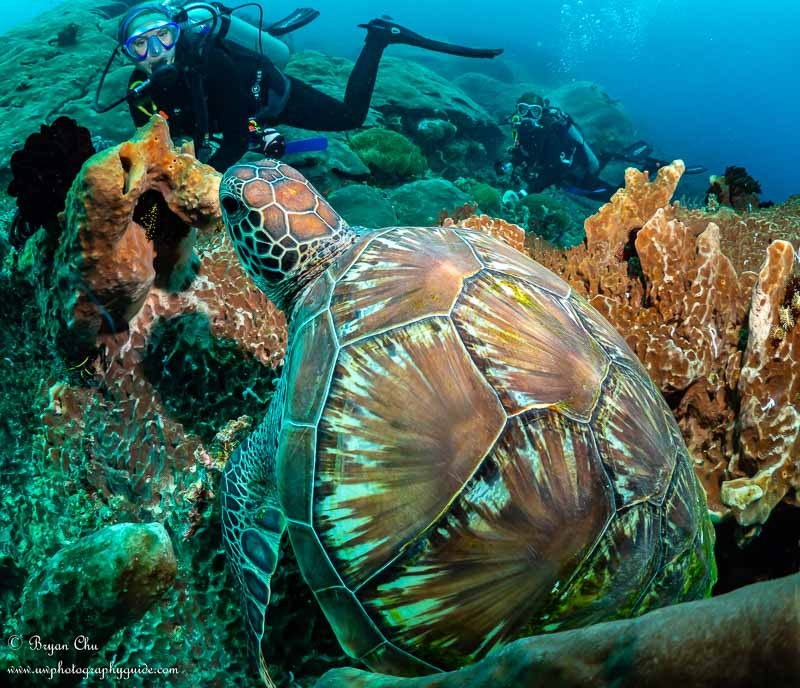
Towards the end of the dive we found a huge green sea turtle, more than a meter long, hanging out on the sand. It was a perfect photo opportunity, so I got our awesome dive guide/dive model Nicole in behind it, put my strobes up and got a shot I was really happy with!
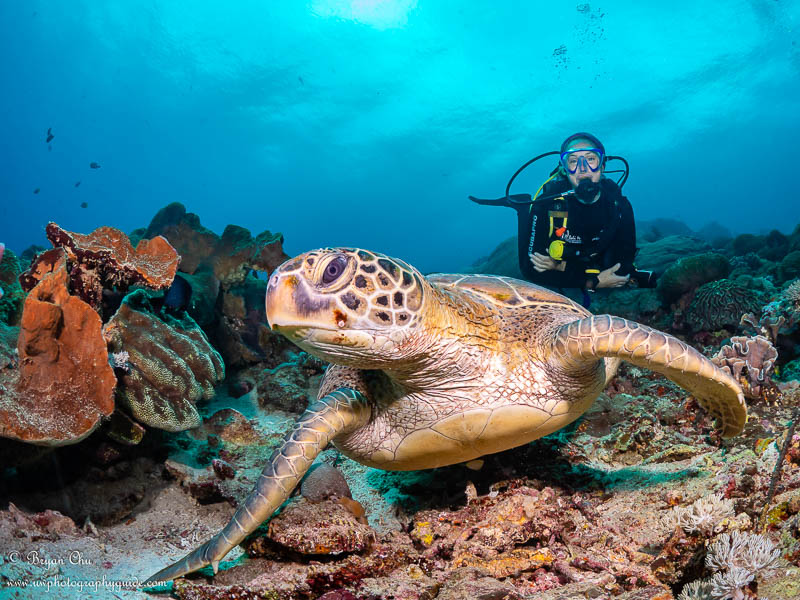
I have never really liked sponges, other than maybe Spongebob Squarepants. That sounds a bit harsh…I mean I have never really disliked them either. I guess I have just never really noticed them before. But here it was very hard to miss them – on some of the drift dives we did, they were monstrously huge! It also turned out that, although giant and very stationary, they were often quite hard to photograph! Most places we saw them had a decent amount of current to contend with, and I wanted my shots with dive models above. So it involved a lot of frantic signalling, grabbing a rock with one hand and adjusting settings with the other, getting Lisa to grab onto a rock, and then getting Nicole, probably the most patient dive model ever, to get in position.
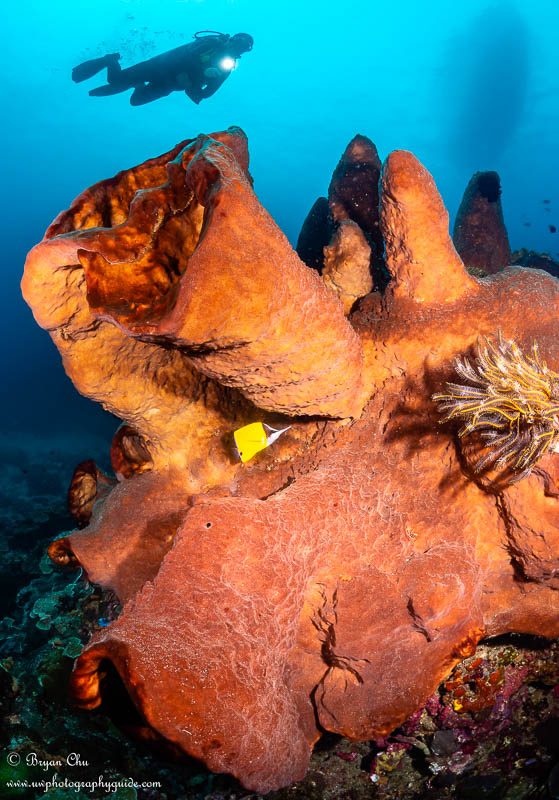
When I was ready, we would both let go and swim against the current, me getting in the right spot to take the photo, and her getting in the right spot to appear in the photo. At times it was like being on an underwater treadmill, with me snapping away shot after shot, and Nicole struggling to stay in one spot while also looking like she was effortlessly hovering in the blue. Lots of work and a lot of missed opportunities, but the keepers were worth it!
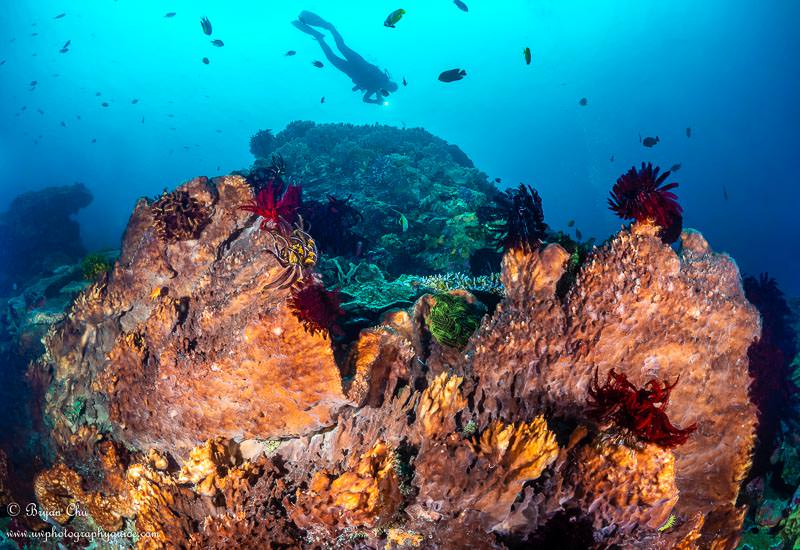
Crystal Bay is both famous and infamous. This is the place where you can find mola mola and other pelagics when the conditions are right. For mola, this means really cold water! It is also very well known for having sometimes-gnarly down-currents, if one ventures out from the bay and towards the point. Our dive guides told us we had to stay close to them and close to the reef. If we saw them grab on, we needed to grab on, and if we saw all the fish heading down for the reef, that also meant it was time to grab on.
When we were there, the water was too warm for molas, but we still dove the bay to enjoy the reefs. (Though our last dive of the trip, at Sental, we did see a mola jump out of the water! We went looking for it underwater, but alas, no luck). The reef on one side of the bay is beautiful branched coral, very healthy and covered in fish. We experienced some of the promised down-currents, but none were particularly bad, and it was easy to grab on to a rock and just hang out until they passed.
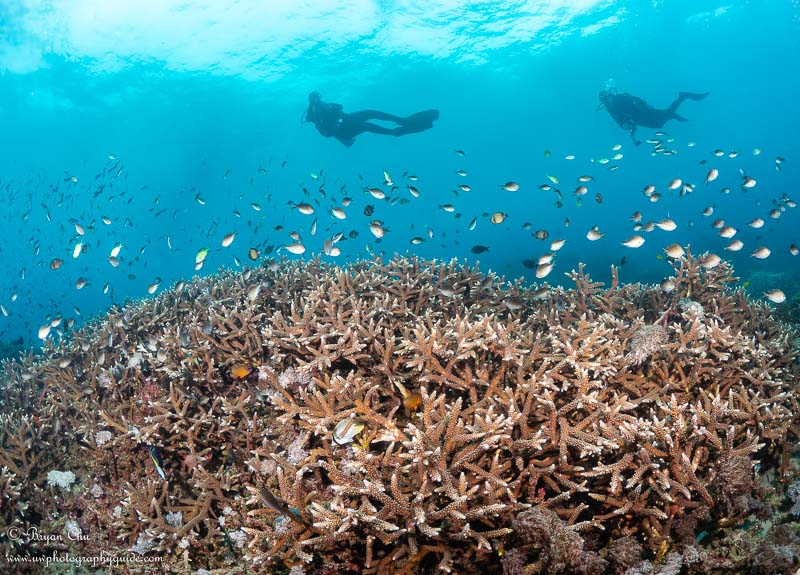
Unfortunately, Crystal Bay got hit by some really stormy weather a year or two ago…and by stormy we are talking 6 m swells. This smashed up what had been a beautiful reef on the other side of the bay, destroying much of the hard coral. Things were starting to recover, but it will be quite a few years before it returns to its former glory. Too bad, but it is still a great dive site!
One day we decided to go to Manta Bay instead of Manta Point, as Manta Point was too quiet (and quiet means only 3-4 mantas per dive). The visibility was not great, and there must just not have been a lot of mantas around Nusa Penida, for whatever reason. We didn’t see any mantas at all, but in compensation for straining our neck and eyes looking for them throughout the dive, we saw a bamboo shark sharing a cave with a turtle, and a really awesome octopus. You can read more about this friendly octopus encounter here.
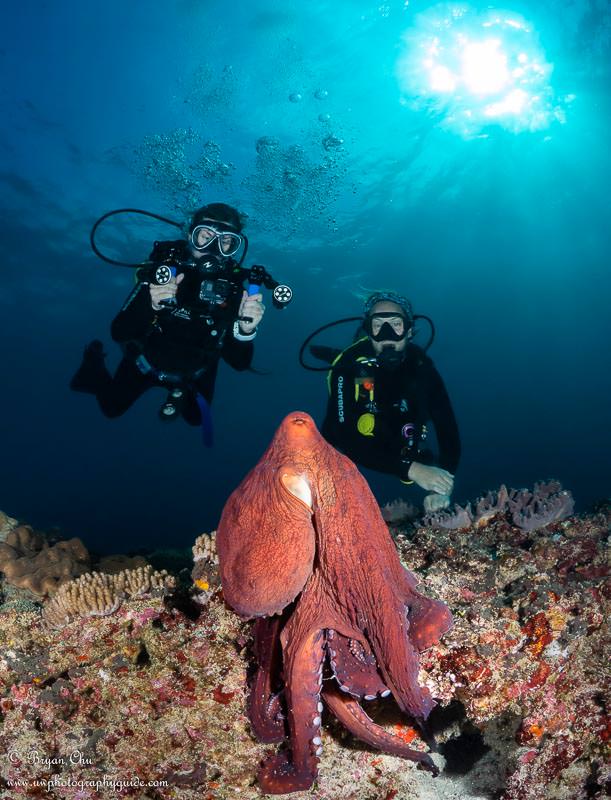
Laid-Back Lembongan House Reef
Most of our diving was done on Nusa Penida, but Bali Hai Dive Adventures also has a floating dive facility/pontoon in a bay in Lembongan. It is super easy to gear up, and then you just go down the steps into the water. Although the visibility is not as good, and the reefs not as spectacular as some of the ones on Nusa Penida, they are still very nice! And did I mention, very easy to dive? It was perfect for our check-out dive.
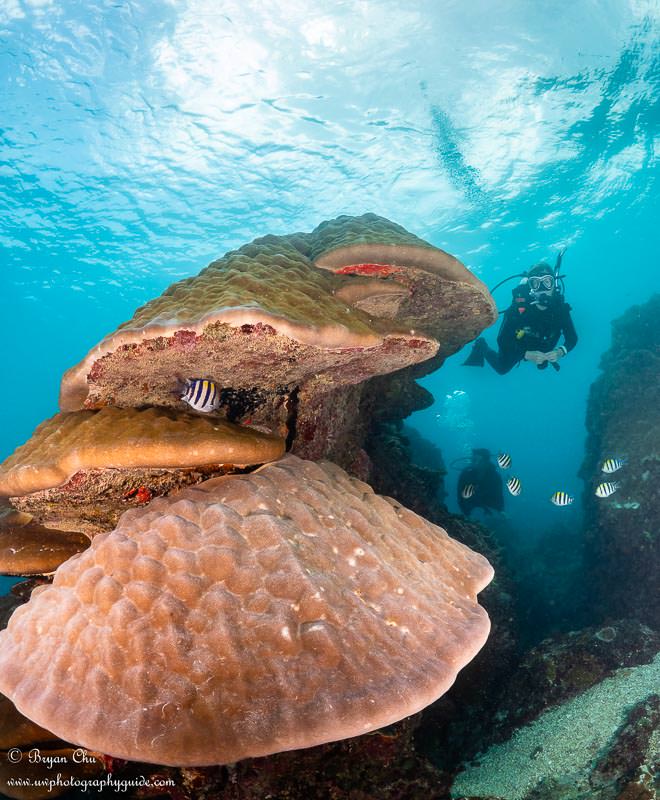
There is one anemone with some absolutely massive false clown anemonefish, which we spent a lot of time hanging out with. I set up my dive models behind the anemone and starting taking photos, and was really appreciating how “friendly” the clownfish were. They were swimming right up, checking out my strobes and dome port, and generally posing quite nicely.
Then, at one point while adjusting my settings, I felt a bite on my finger! It turns out these fish weren’t friendly at all, but were just figuring out the best place to attack. And I have to credit them, although not as effective as, say, biting my ear, my finger was a much better target than the strobes or dome port. I looked up and saw my dive models laughing like it was the funniest thing they had ever seen, though I did not agree. Fortunately, I was able to get some good shots of the cheeky female.
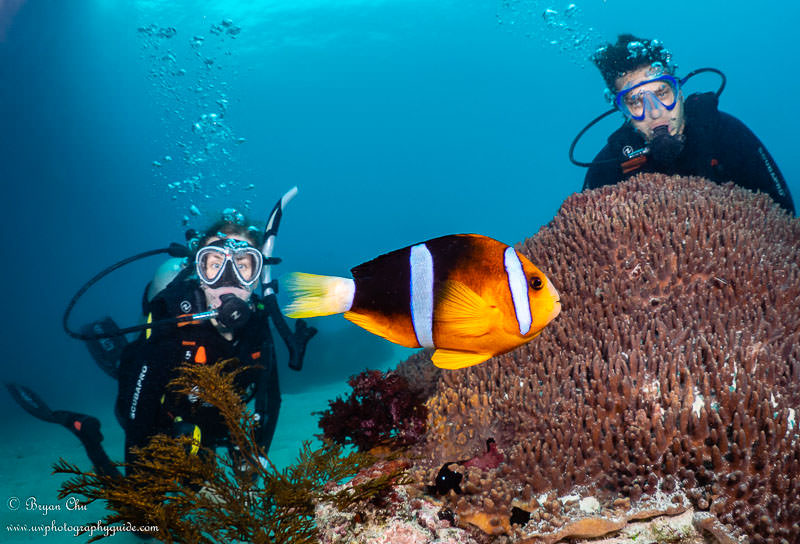
Another great thing at the pontoon is a very cool initiative that Bali Hai has taken on: their coral restoration project. They grow pieces of coral and then wire tie them on to metal rods, which they attach to the bottom. Then, the coral grows over this metal skeleton, restoring sandy areas back to some beautiful hard coral reefs.
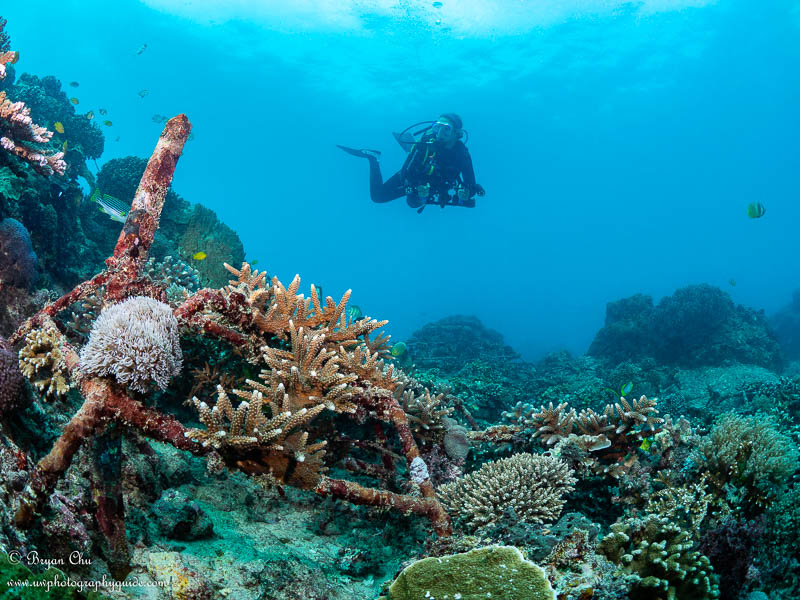
Overall we did a couple of dives at the pontoon, and they were quite enjoyable.
There are a couple of other dive sites off Lembongan, but as there were no mola around and conditions weren't the best, we did not dive them. Nusa Penida had more than enough to keep us very busy!
When to Dive Nusa Penida & Lembongan
Diving season for Penida and Lembongan is year 'round, though there are significant variations in diving conditions and pelagic encounters depending on the time of year.
Best Time for Mantas
Mantas are easy. There is a 90% chance of seeing them year-round on the south of Penida Island. The main concern is not about whether you will find them, but if you can beat the crowds and get more intimate, small-group encounters.
Best Time for Mola Mola (Oceanic Sunfish) & Water Temperatures
Mola mola come in with the cold water, and are only encountered when the water temperatures drop significantly. This is typically from June through October, when cold waters are carried up from Australia. The most sightings are reported during August, but that is also when there are the most divers in the water. During cold water periods, statistically the best time for mola sightings are at or close to the full moon. Of course the full moon also means the craziest currents, so if shooting for this timeframe, it can pay dividends to be prepared and to dive at slack tide.
Water temperatures during mola season range from 18-24 C (64 - 75) with reports of localized low temperatures a few degrees below that.
Water temperatures outside mola season are much warmer (of course), ranging from 24-28 C (75 - 82 F).
Seasons for Visiting
- Dry season: May to October, which is also the busier period for tourists
- Tourist peak season: July, August and September are typically the busiest months
- Wet season: November to April, with rain typically occurring in the late afternoon, evening or at night, and lots of sunshine during the day. Note that Lembongan has no rivers, so rain has less of a negative effect on visibility than in many other locations
- Monsoon season: December to March, with more risk of storms and rough seas, though diving is done year 'round.
I personally prefer to visit places in shoulder season, when they are less busy. This is both cheaper and more fun for diving. We went in April, which was perfect, as the rain only happened in the afternoon or at night, we had nice sunny days, excellent visibility, and very warm water.
The only problem was we missed out on the molas, so we are planning to return. Lisa has never seen a mola, and we are thinking we will shoot for October. October is another shoulder season month, so quite a bit less busy and crowded, but still with lots of cold water and potential for mola mola encounters. And as water temperatures tend to start increasing mid-November, even early November can have some nice mola potential, with even less tourists.
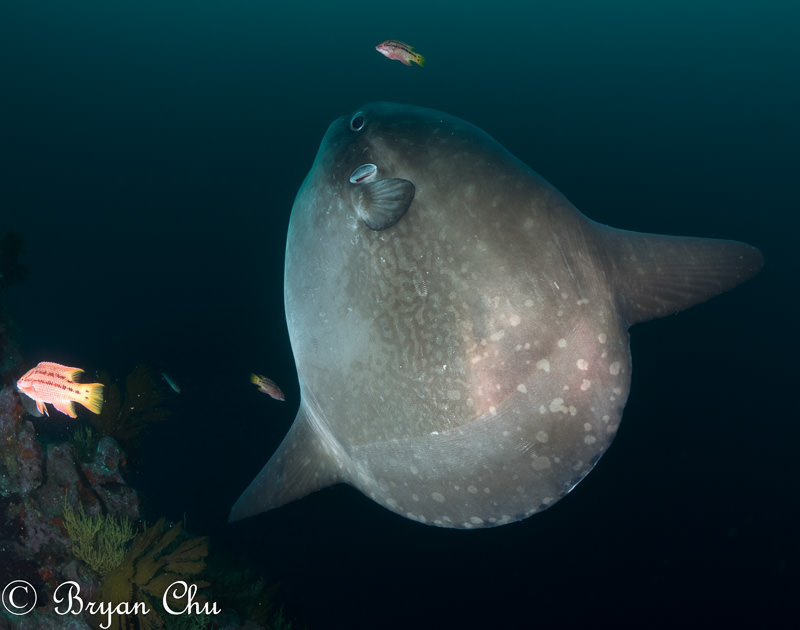
How to Dive Nusa Penida & Lembongan
If you want to do anything more than just 1 or 2 dives (which you really should!), then the best way to dive Nusa Penida and Lembongan is by staying on Nusa Penida or Lembongan. The biggest advantage is that you get to the busy dive sites (Manta Point all year around, and Crystal Bay or other mola sites during mola mola season) ahead of the crowds from Bali. This is huge, because once all the boats from Bali arrive, the popular dive sites can become fairly crowded, making for a much worse underwater experience.
This also saves a lot of time in transit on the dive boat and to/from the dive operation, especially if you stay at a resort with an in-house dive shop. It may not seem like much, but being able to walk to the dive shop in 2 minutes, have a breakfast packed for your boat ride to manta point, getting back to enjoy a great BBQ lunch, and being done the third dive pretty early in the afternoon is awesome.
It gives you a lot more time to relax and enjoy the beautiful island, as well as sort photos, tend to photo equipment, and so on. And the earliest you ever have to get going in the morning is 7:15, with starts after 8 if you are not going to Manta Point. Being less tired for the dives, especially the more difficult ones with challenging current or surge, can make a big difference to enjoyment level!
The other thing you'll want to do to have the best experience diving here is to go with a dive operator that only runs small dive groups. I have seen videos of large dive groups, with everyone rushing straight at mola mola, and it does not look like a fun experience. Same goes for being in a big group at manta point, all waiting in a line for mantas to swim over. And when it gets to doing some of those beautiful reef drift dives, a big group would be a nightmare, especially with people of varying skill levels.
Although it is more expensive to stay on Penida or Lembongan, and to dive with an operator who has small groups, it is money very well spent. Who cares how cheap your dives are if you spend half the time getting kicked by fins and cut off by newly certified divers shoving their GoPro sticks in front of them and chasing everything in sight?
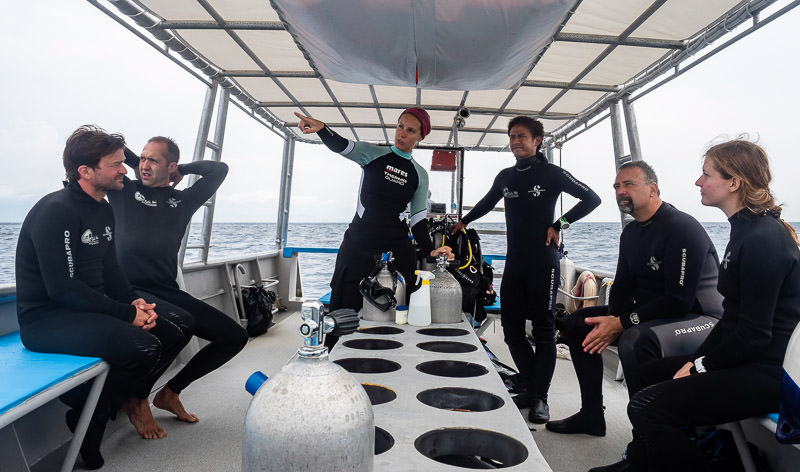
As mentioned, we stayed at the Hai Tide Beach Resort and went diving with their in-house shop, Bali Hai Diving Adventures. The resort was very comfortable, with two really nice pools and awesome food, and the dive shop was one of the best operations I have dove with. The boat was clean and spacious, and they run a maximum ratio of 4 divers per dive guide. If the divers have significantly varying levels of experience, then they may go down to 2 divers per guide, which is even better - no coming up after 30 minutes underwater, with half a tank of air left over!
Book Your Trip to Nusa Penida & Lembongan!

Our sister company Bluewater Dive Travel has lots of experience booking dive trips to Bali and Nusa Penida/Lembongan. So if you want help planning your trip, drop them a line at info@bluewaterdivetravel.com!
- Learn more about Bali Hai Diving Adventures
- Check out their Bali Diving guide to help plan a larger trip
Thanks for reading and I hope you found this useful! As always, if you have any questions about the destination, gear or techniques, feel free to drop me a line at bryan@uwphotographyguide.com.
Gear Links
Here are the latest versions of the gear I am shooting.
RECOMMENDED ARTICLES
SUPPORT THE UNDERWATER PHOTOGRAPHY GUIDE:
The Best Service & Prices on u/w Photo Gear
 Visit Bluewater Photo & Video for all your underwater photography and video gear. Click, or call the team at (310) 633-5052 for expert advice!
Visit Bluewater Photo & Video for all your underwater photography and video gear. Click, or call the team at (310) 633-5052 for expert advice!
The Best Pricing, Service & Expert Advice to Book your Dive Trips
 Bluewater Travel is your full-service scuba travel agency. Let our expert advisers plan and book your next dive vacation. Run by divers, for divers.
Bluewater Travel is your full-service scuba travel agency. Let our expert advisers plan and book your next dive vacation. Run by divers, for divers.


































